1/28/2023
Citations:
Federici, Silvia. Caliban and the Witch: Women, the Body and Primitive Accumulation. Buy here!
Marx, Karl. Capital: A Critique of Political Economy. Vol. 1, Penguin, 1992. Buy here!
Shakespeare, William. The Tempest. Buy here!
Locke, John. Two Treatises of Government. Edited by Mark Goldie, Everyman, 1999. Buy here!
Foucault, Michel. Power/Knowledge: Selected Interviews and Other Writings 1972-1977. Buy here!
As an Amazon Associate, I earn from qualifying purchases.
Chapter 2. The Accumulation of Labor & the Degradation of Women: Constructing ‘Difference’ in the ‘Transition to Capitalism’
“I demand whether all wars, bloodshed and misery came not upon the creation when one man endeavoured to be a lord over another?…. And whether this misery shall not remove…. when all the branches of mankind shall look upon the earth as one common treasury to all.”
Gerrard Wistanley, The New Law of Righteousness, 1649
“To him she was a fragmented commodity whose feelings and choices were rarely considered: her head & her heart were separated from her back and her hands and divided from her womb & vagina. Her back & muscle were pressed into field labor…. her hands were demanded to nurse & nurture the white man…. Her vagina, used for his sexual pleasure, was the gateway to the womb, which was his place of capital investment — the capital investment being the sex-act & the resulting child the accumulated surplus….
Barbara Omolade, “Heart of Darkness,” 1983
“All that glitters is not gold
Shakespeare, Merchant of Venice, 1598
Often you have heard that told
Many a man his life hath sold
But my outside to behold:
Gilded tombs do worms unfold.
Had you been as wise as bold,
Young in limbs, in judgement old,
Your answer had not been inscroll’d:
Fare you well; your suit is cold.”
So, what do you think our warlock friend Shakespeare is trying to say here? Yes, all that glitters is not gold as you have been told. And with his magic he had something more to unfold, that there is no shine even in glittering gold. For if you get to know where all this gold and wealth came from, you would never stop washing your hands tenfold. So horrible is the story of Capitalist primitive accumulation of wealth, full of blood, crime and the degradation of women, like myself. This European story is a road bridging feudalism to capitalism, from the 15th – 17th centuries.
Ultimately, it led to the immiseration of the working class. Primitive accumulation is a road paved with war, land privatization, evictions, rent increases, higher taxation, usury, & religion.
It is I, Lady Hexerai, here (once again) to bring you the good news about witchcraft. Today, we’ll explore the 2nd chapter to the book Caliban and the Witch: Women, the Body and Primitive Accumulation by the philosopher Sylvia Federici.
This chapter is entitled: “The Accumulation of Labor & the Degradation of Women: Constructing ‘Difference’ in the ‘Transition to Capitalism’.” What a mouth full. I need a drink of my potion. I call my wine potions.
The End of Feudalism
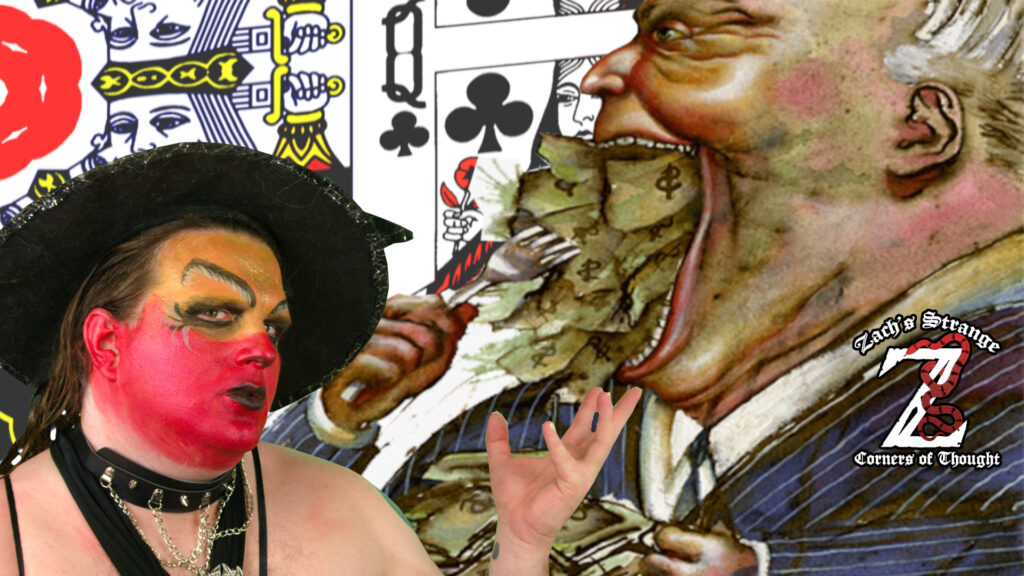
I have already told you in the first video about the innumerable internal and external crisis that the feudal society faced. There was a strong reaction and many responses to this crisis. The strongest of all these responses was the development of a completely new economic and social system “Capitalism”. Federici says that Capitalism wasn’t the only response as there had been many put forth to solve the crisis of feudalism.
“Throughout Europe, vast communalistic social movements and rebellions against feudalism had offered the promise of a new egalitarian society built on social equality and cooperation. However, by 1525 their most powerful expression, ‘Peasant War’ in Germany or, as Peter Blickle called it, ‘the revolution of the common man” was crushed.’
Page 61
Over 100,000 peasant rebels were massacred during the Peasant War.
Then, in 1525, the “Anabaptists” suffered a downfall with the division of its own leaders who had taken a patriarchal turn by imposing polygamy that caused women to revolt against them, and then later they ended in a great bloodbath by the opposite forces.
Despite these victories by the nobility, the Church, and the new town merchant class, feudalism was doomed. It could no longer reproduce itself. As we spoke in the previous video, Feudalism was based on the relation of a vassal to a lord. The lowest yet most numerous vassals were the serfs. The social relation of serfdom was a specific kind of social division vastly different than the ones that exist today. Serfs were given a small plot of land, called a fief, to live and grow crops on in fealty (literally, in fee) to a lord. Serfs were taught that obedience and service to their lords without question would lead to the kingdom of Heaven. Yet, back in the real world, most serfs had no possibility of upward social mobility. With the chance to rise above their station practically non-existent, there was small incentive for them to do more than what was required.
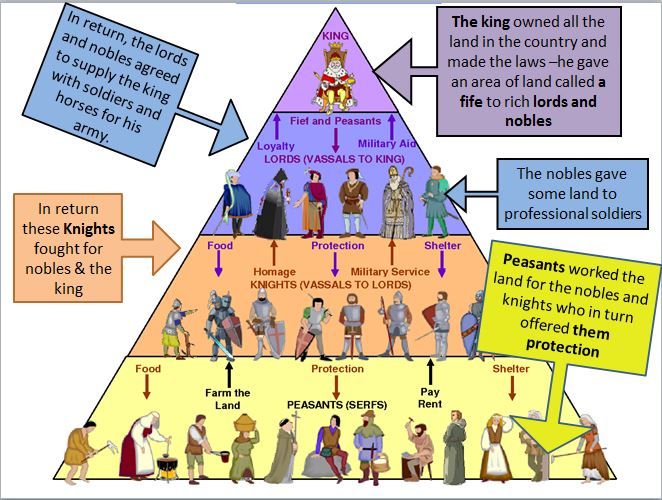
Feudal wealth was also very different from today. The Church & Nobility had its coffers full of gold and silver which it either kept in its strong boxes or used it to buy ornaments for alters. It was a great fortune but it was idle capital, not continually at work as fortunes are today. Whatever money the nobility had was motionless, dead and fixed.
Commutation changed all this in the 13th century. Commutation, where peasants were paid wages for the work they owed to their lord and the lord charged them money rent, shattered the closed economies of the feudal system.
Now any crops beyond what was needed could be sold and in return serfs could get money. The serfs were not entirely at home with the use of money, but they were getting more and more familiar with it. Commutation created the first, primitive engines of capitalism as capital began to move beyond manorial villages.
Large numbers of peasants began to move about, sell or bequeath their land, although they had to make certain payments for doing so. Commutation also caused many serfs to lose their land. Serfs would go into debt to pay for their rents, eventually becoming landless. No longer bounded to the land, they moved to the reemerging cities for new opportunities. The force of change swept over Europe and gave it a new face.
As we said earlier, feudalism was doomed. Yes, that’s right.
On top of commutation, there was the devastation of the Black death. It washed off more than half of the peasant population. Labor was more valuable then ever. As Sister Federici states:
“The real wage increased by 100%, prices declined by 33%, rents also declined, the length of the working day decreased, and a tendency appeared toward local self-sufficiency. Evidence of a chronic disaccumulation trend in this period is also found in the pessimism of the contemporary merchants and landowners, and the measures which the European states adopted to protect markets, suppress competition and force people to work at the conditions imposed. As the entries in the registers of the feudal manors recorded, ‘the work was not worth the breakfast.’ The feudal economy could not reproduce itself, nor could a capitalist society have evolved from it, for self-sufficiency and the new high-wage regime allowed for the wealth of the people, but excluded the possibility of capitalist wealth.”
Page 62
It’s not like feudalism didn’t try. There was an attempt at a return to serfdom before commutation, but it was strenuously resisted. Only in Eastern Europe where the population was especially low did serfdom reappear. Attempts were made, especially in Italy, at imposing chattel-slavery but the conditions simply didn’t exist to break the will of the serfdom. All was for naught.
The “so-called” Transition to Capitalism
Sister Federici says:
“It was in response to this crisis that the European ruling class launched the global offensive that in the course of at least three centuries was to change the history of the planet, laying the foundations of a capitalist world-system, in the relentless attempt to appropriate new sources of wealth, expand its economic basis, and bring new workers under its command.”
Page 62
Yet, capitalism was not yet at a point where it could reproduce itself either.
This period, the 15th, 16th, and 17th centuries, is when the so-called transition from Feudalism to Capitalism occurred. We say “so called” because Federici says the term “transition means” a slow gradual process, but this change was so abrupt and lethal that historians have labelled this period the Iron Age, the Age of Plunder, the age of the Whip. Enlightenment thinkers and capitalist historians would have you believe that history & knowledge move progressively from ignorance to enlightenment. There is an inevitability to history in their minds. But, as Sister Federici said earlier, it was not a foregone conclusion that Capitalism would emerge on top. For three centuries, there were bloody and unending conflicts between different groups of exploiters and exploitees. All witches know, history is never a straight line. Here, Sister Federici is agreeing with the warlock Michel Foucault. Foucault said in an interview entitled “Truth & Power”:
“It seemed to me that in certain empirical forms of knowledge like biology, political economy, psychiatry, medicine etc., the rhythm of transformation doesn’t follow the smooth, continuist schemas of development which are normally accepted. The great biological image of a progressive maturation of science still underpins a good many historical analyses; it does not seem to me to be pertinent to history.”
Foucault, Michel. Power/Knowledge: Selected Interviews and Other Writings 1972-1977. 111-112.
History isn’t smooth, its messy, discontinuous, occurs through innumerable micro-struggles, starts in fitz and burst and annihilates in a second. The science of the enlightenment led to phrenology, the “science” of studying cranial size to understand the psychology of someone, to scientific racism like eugenics which directly led to the horrors of the holocaust. How progressive?
Sister Federici only uses the term transition in a chronological sense for defining this period between feudalism and capitalism that arose in the 15th and 16th centuries. In this change, the exploitation and the subjugation of the common peoples would worsen at home and spread abroad in the forms of slavery.
How silly of me? I forgot to explain what capitalism is. Just like the way I explained feudalism to you in the previous video with the use of my magic cauldron, I will explain Capitalism with the use of my magic wand. Here you go! Beware you are up for an informative ride! But, I warn you, as curiosity kills the cat, knowledge can kill a witch!
Boy, boy, come here and explain to the audience what capitalism is!
Marx: Boy? I’m no boy. I’ll have you know I’m over 200 years old–
Lady Hexarai: I’ve lived over a thousand years, have seen the greatest of kingdoms rise & fall, and many a boy has been felled by my spells alone. Obey your seniors and do as I command.
Marx: Yes, as you command.
Lady Hexarai: And get me more potion.
Marx: Well, you see, capitalism is made up of two groups: the proletariat and the bourgeoisie. The proletariat is made up of the vast majority of people who have to sell their labor in order to survive. While the Bourgeoisie are the capitalists which hoard wealth and exploit the proletariat. All value is derived from labor. It is the capitalist which concentrates and manages labor in such a way that the surplus increase in value from labor is expropriated from the proletariat and added to the coffers of the bosses. Capital itself is merely dead suprlus-labor stolen by the wealthy.
Yet, we reach an interesting problem. For:
“the accumulation of capital presupposes surplus-value; surplus-value presupposes capitalist production; capitalist production presupposes the availability of considerable masses of capital and labor-power in the hands of commodity producers. The whole movement, therefore, seems to turn around in a never-ending circle, which we can only get out of by assuming a primitive accumulation which precedes capitalist accumulation; an accumulation which is not the result of the capitalist mode of production but its point of departure.”
Marx, Karl. Das Kapital. 873
Ultimately, capitalism could not have emerged without 1) a prior concentration of capital, land, & labor; and 2) contrary to the vulgar economists like Adam Smith, capitalist wealth was not created by the abstinence of the rich, but by the divorcing of the workers from the means of production.
Lady Hexarai: That’s enough child.
While it was not inevitable that capitalism would dominate, in order for capitalism to successfully transition it was necessary that primitive accumulation occur.
From here, Sister Federici departs from Marx in greatly expanding our understanding of primitive accumulation. She argues the following points:
“I. The expropriation of European workers from their means of subsistence, and the enslavement of Native Americans & Africans to the mines & plantations of the ‘New World,’ were not the only means by which a world proletariat was formed and ‘accumulated.’
II. This process required the transformation of the body into a work-machine, and the subjugation of women to the reproduction of the work-force. Most of all, it required the destruction of the power of women which, in Europe as in America, was achieved through the extermination of ‘witches.’
III. Primitive Accumulation, then, was not simply an accumulation and concentration of exploitable workers and capital. It was also an accumulation of differences and divisions within the working class, whereby hierarchies built upon gender, as well as ‘race’ and age. Became constitutive of class rule and the formation of the modern proletariat.
IV. We cannot, therefore, identify capitalist accumulation with the liberation of the worker, female or male as many Marxists have done, or see the advent of capitalism as a moment of historical progress. On the contrary, capitalism has created more brutal and insidious forms of enslavement, as it has planted into the body of the proletariat deep divisions that have served to intensify and conceal exploitation. It is in great part because of these imposed divisions—especially those between women & men—that capitalist accumulation continues to devastate life in every corner of the planet.”
Page 63-64
There were three main objectives that had to be fulfilled for capitalism to transition into existence:
a. create a more disciplined work-force
b. diffuse social protests
c. fix workers to jobs forced on them
During this time of no-longer-feudalism and not-quite-capitalism, the best description of the economic system is mercantilism. Mercantilism is often dismissed by capitalist historians as a vulgar phase, but the brutality of this vulgarity is exactly what made it necessary to primitive accumulation. We will go into greater detail later, but Sister Federici describes Mercantilism as follows:
- invented work-houses, punished vagabonds, transported criminals to Americas, & invested in slave trade
- asserted the utility of poverty while condemning idleness as a social plague
- expresses the requirements of PA
- intensive – totalitarian regime to extract maximum amount of work
- extensive – study reproduction of labor; expand population; expand army & workforce
- defined humans as machines or raw materials
- created pro-natalist methods, punishing contraception, abortion, infanticide, and non-procreative sex.
- forced male drs to be present at birth, marginalization of midwives
- midwife marginalization led to women losing control over reproductive functions
- women became enslaved to procreation; what was previously a private affair became public controlled by men & state

The Greatest Land-Grab in Human History
In the year of 2008, the entire global economy collapsed because of the massive land grab and speculative bubble created by massive investment banks. And, like any good capitalist state, the government bailed out those banks. But, this land grab pales in comparison to that which occurred during the centuries of primitive accumulation.
The main forms of land theft were war, religious division, and the enclosure of the commons.
Prior to the fifteen hundreds, wars, while common (who doesn’t love a “just” war after all) were brief and irregular affairs, which mainly occurred during the summer months. Most armies were largely made of peasants needed to sow their crops. Military campaigns largely occurred during the summer months.
Yet, the transition to capitalism necessitated more frequent wars, longer campaigns, and nation’s with increasingly permanent and professional standing armies. Armies grew tenfold, and new technologies in Europe like gunpowder, for both guns and cannons, made war bloodier and more damaging. During Feudalism, attacking a castle would often lead to a slow war of attrition by sieging the castle and cutting it off from its lands. Disobedient lords could hole up in their castles for years. But cannons could make short work of a castle wall in only a few days. The European states frequently turned to territorial conquest to handle economic crisis (though there were also religious reasons) and the burgeoning capitalist class was only too happy to finance them.
Major military conflicts during this period include:
- The Dano-Swedish War (1501-1512)
- The Dutch Guelder Wars (1502-1543)
- The Portuguese-Mamluk naval war (1505-1507)
- War of the League of Cambrai (1508-1516)
- Fourth Muscovite–Lithuanian War (1512-1522)
- The Spanish Conquest of Iberian Navarre (1512-21)
- The Livonian War (1558-1583)
- The French Wars of Religion (1562-1598)
- Northern Seven Years War (1563-1570)
- The Eighty Years War (1568-1648)
- The Anglo-Spanish War (1585-1604)
- Nine Years War in Ireland (1594-1603)
- The Thirty-Years Wars (1618-1648)
- The Franco-Spanish Wars (1635-1659)
- The Portuguese Restoration War (1640-1668)
- The Irish Confederate War (1641-1653)
- Multiple English Civil Wars lasting from (1642-1651)
- The Russo-Polish War (1654-1667)
- The Long Turkish War (1591-1606)
- The Great Turkish War (1683-1699)
- The Nine Years War which, surprisingly, lasted for nine years between 1688-1697
And that’s just the major wars during the 16th-17th centuries. Don’t even get me started about the 18th century.
The Protestant reformation was also a major source for the transfer of land into new hands. During Feudalism, most Church property throughout Europe was non-taxable, often times generated wealth for the Church, and in many cases, had legal jurisdiction over its lands outside the power of the nobility. Kings and lords hated that there were criminals within their lands they couldn’t punish. Yet, with the rise of Protestantism, Lutheran and Calvinist Lords were only too happy to seize Catholic property and make it there own. In England, the break from Rome and the rise of Anglicanism not only allowed King Henry the VIII to marry whomever he pleased, but it also allowed him to seize all church lands and whatever wealth they contained. Of course, the many peasants who had converted to Protestantism on the promise of freedom from church tithes and access to new land were betrayed by the nobility. Those peasants who resisted were deemed fomenters of sedition and were crushed.
Yet, by far, the biggest land grab was land privatization and the enclosure of the commons.
“In Europe land privatization began in the late 15th century, simultaneously with colonial expansion. It took different forms: the evictions of tenants, rent increases, and increased state taxation, leading to debt and the sale of land. I define all these forms as a land expropriation because, even when the force was not used, the loss of land occurred against the individual’s or the community’s will and undermined their capacity for subsistence.”
Page 62
As we said in the last chapter, the commons were essential to peasant life. The serfs could supplement their subsistence living hunting in the forests, fishing in the ponds, and collecting fruits and nuts. All the major peasant celebrations occurred in the Commons, solidarity amongst serfs dwelled in the freedom of the commons, and communal villages would break up areas into tracts of land that could be used for farming. This was called open-field agriculture. Open-field agriculture protected peasants against harvest failure, as they had multiple strips of land to rely on. It allowed a more manageable work schedule (as different strips required attention at different times). It encouraged self-government, self-reliance, and collective decision-making.
But the enclosures changed all that. The commons were marked off into pieces of land for exclusive ownership & occupation. Any peasants living in the commons were forced off the land violently and fences were built barring them access. Capitalist historians, both then and now, decried the the open field agriculture as wasteful, breeding laziness and disorder. The peasants were accused of depleting the fruitfulness of the land, and only a takeover by the rich could save it.
This created the philosophical concept of wasteland property. The modern understanding of property as both a moral & political concept can be traced most succinctly to English philosopher John Locke, who was absolutely not a warlock. Locke, writing in 1680s, believed that common natural resources which were labored on became the private property of the one who labored on it.
“As much land as a man tills, plants, improves, Cultivates, and can use the product of, so much is his property. He by his labor does, as it were, enclose it from the commons.”
Locke, John. Two Treatises of Government. Edited by Mark Goldie, Everyman, 1999. 2nd Treatise pg. 130. Buy here!
Yet, the labor of the peasants was not considered real work for it did not maximize the value of the land according to the emerging capitalist principles. The labor of the peasants left much of the land fallow even unrational. Locke said God gave the world in common to all but He did not mean for it to remain common and uncultivated.
“He gave it to the use of the industrious and rational, (and labor was to be his title to it;) not to the fancy or covetousness of the quarrelsome and contentious.”
Locke, John. Two Treatises of Government. Edited by Mark Goldie, Everyman, 1999. 2nd Treatise pg. 131. Buy here!
It was the rational nobles and industrious capitalists whose work was deemed proper to property. In reality, their work was not the actual labor which cultivated the land, but the right to use violence to control the land and enclose it. And any land which was deemed irrationally uncultivated was deemed wasteland, and anyone could take that land even if there were people living on it.
“Nothing was made by God for man to spoil or destroy.”
Locke, John. Two Treatises of Government. Edited by Mark Goldie, Everyman, 1999. 2nd Treatise pg. 130. Buy here!
This thinking justified enclosure of common lands and the abolition of open field agriculture by force if necessary. Locke said God commanded man to subdue the Earth for the benefit of human life, and, Locke believed, this would benefit all of mankind if all public wasteland was expropriated into private property. Property, for Locke, was a moral demand and a right for those individuals who possessed self-evident civil rights. Private property was a natural result of human rationality. This was the justification for all forms of land expropriation, from the privatization of land in Europe, to the brutal colonial theft of land in Africa, the Caribbean, and the Americas.
Contrary to capitalist revisionism, land privatization led to two centuries of starvation. More food was created, but it was not for the masses, not for immediate consumption but for the market and to be exported. Sister Federici says:
“A testimony to the misery produced by land privatization is the fact that, barely a century after the emergence of agrarian capitalism, sixty European towns had instituted some form of social assistance or were moving in this direction, and vagabondage had become an international problem.”
Page 70
The farmers now had no land of their own! The ground under their feet was ripped out from under them. It created more extreme divisions amongst the peasantry. Sister Frederici says:
“Not only did cooperation die when land was privatized and individual labor contracts replaced collective ones; economic differences among the rural population deepened, as the number of poor squatters increased who had nothing left but a cot and a cow, and no choice but to go with bended knee and cap in hand to beg for a job. Social cohesion broke down; families disintegrated, the youth left the village to join the increasing number of vagabonds or itinerant workers—soon to become the social problem of the age—while the elderly were left behind to fend for themselves. Particularly disadvantaged were older women who, no longer supported by their children, fell into the poor rolls or survived by borrowing, petty theft, and delayed payments. The outcome was a peasantry polarized not only by the deepening economic inequalities, but by a web of hatred and resentments.”
Page 72
Federici further says:
“It was not the workers–male or female–who were liberated by land privatization. What was ‘liberated’ was capital, as the land was now ‘free’ to function as a means of accumulation and exploitation, rather than a means of subsistence.”
Page 75
Woman had it the worst when the land was stolen and the rural villages demolished. It was more difficult for women to become vagabonds or migrants, as this exposed them to male violence. Women were also less mobile because of pregnancies and children. Nor could women become soldiers, though many joined armies as cooks, washers, prostitutes and wives; but, by the 17th century, as militaries became more professionalized, the crowds of women which followed armies were banished.
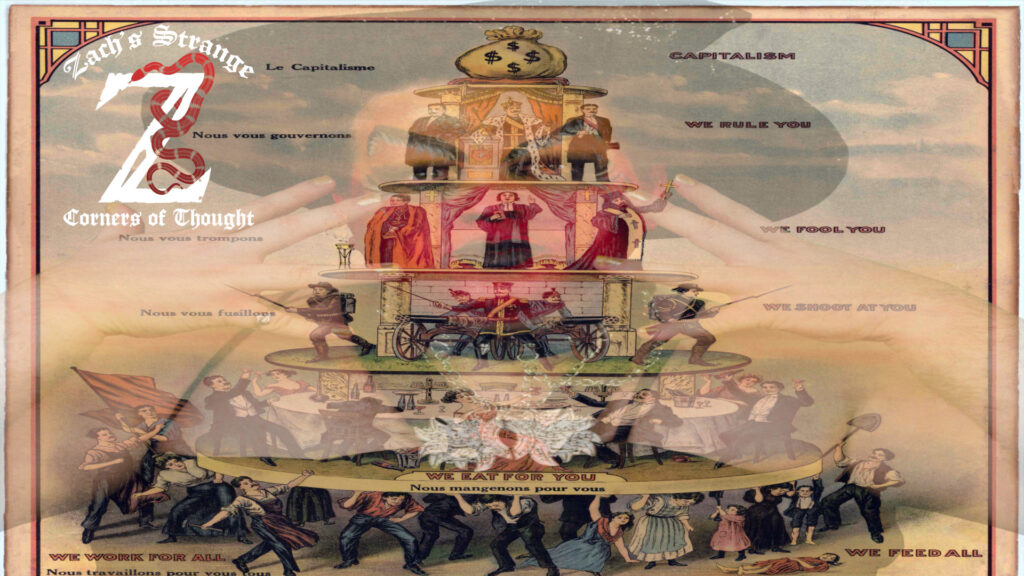
The Price Revolution and the Pauperization & Criminalization of the Working Class
After the enclosures and privatization of land, the peasants lost the common land and became landless.
Now the poor peasants had no choice but to sell the only thing they were now left with: their labor power. And it started to be bought way cheaper than its real value. It was either exploitation or starvation that awaited them. They either turned to wage work or became beggars. In the feudal times, no matter how restricted the peasants were, there was still some natural affiliation with the land he farmed or the roof he lived under. When commutation first emerged, it was seen as a form of freedom. But, without the commons, it became an even tighter chain than feudal obligations. This chain was a noose around the neck of the bourgeoning proletariat, a chain raising them far into the air because of what has become known as the Price Revolution.
Marx: Revolution?
Lady Hexerai: Not that kind boy! Bring me more potion!
With every cause, there is an effect. The theft of land and enslavement of the native populations in America returned to Europe a thousand fold or more. The Spanish raped and enslaved their way through Central & Southern America. The enslaved natives were forced to mine precious metals which would be exported by the literal boatloads back to Europe.
Did this huge supply of silver which was brought from America to Spain stay in Spain? Not at all, it was circulated all over Europe as fast as it poured in. The kings of Spain fought one series of stupid wars after another-they paid in money for supplies and soldiers. The Spaniards bought more goods than they sold. Turns out, you can’t eat silver! Their money filtered through their hands into the pockets of the merchants who sold to them. The rapid influx of gold & silver caused an inflationary phenomenon hitherto unseen.
Yet, Sister Federici notes the unique circumstances that allowed an increase in precious metals to have such devastating inflationary outcomes.
“If they [gold & silver] functioned as price-regulating devices, capable of turning even wheat into a precious commodity, this was because they were planted into a developing capitalist world, in which a growing percentage of the population—one-third in England—had no access to land and had to buy the food that they had once produced, and because the ruling class had learned to use the magical power of money to cut labor costs. In other words, prices rose because of the development of a national and international market-system encouraging the export-import of agricultural products, and because merchants hoarded goods to sell them later at a higher price… It was under these circumstances that the arrival of the American treasure triggered a massive redistribution of wealth and a new proletarianization process. Rising prices ruined the small farmers, who had to give up their land to buy grain or bread when the harvest could not feed their families, and created a class of capitalist entrepreneurs, who accumulated fortunes by investing in agriculture and money-lending, at a time when having money was for many people a matter of life or death.”
Page 76
Wages fell by yuuuuuuuge numbers. In 1600 in Spain, real wages lost thirty percent of their purchasing power compared to 1511.
From the year 1450-1800, wages in England fell by two-thirds. In France, wages dropped sixty percent from 1470-1570. For women, like myself, the consequences were more severe. In the 14th century, women made half of what men did in wage-work. By 1600, it was a mere third of a man’s. Is it any wonder that during this period, the oldest known profession, prostitution skyrocketed? Here you can see the wage devaluation in Southern England, Alsace, & France from 1440-1640.
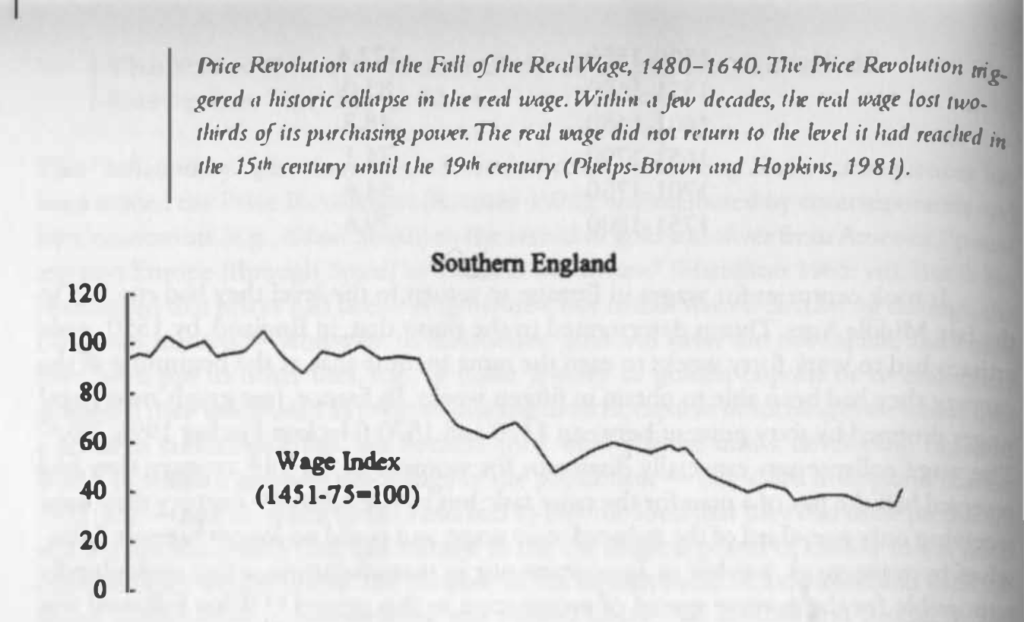
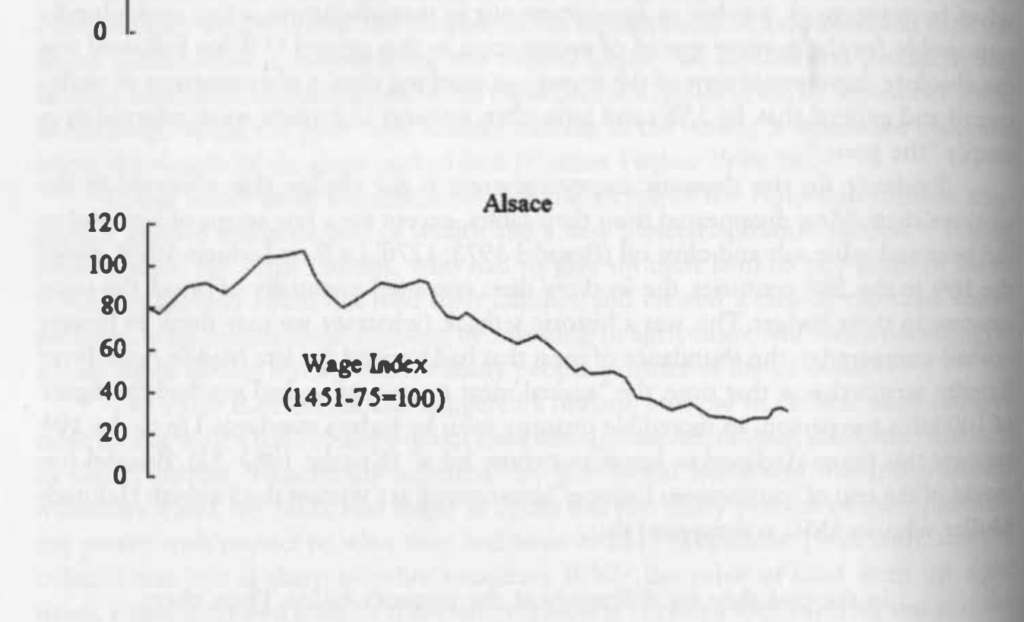
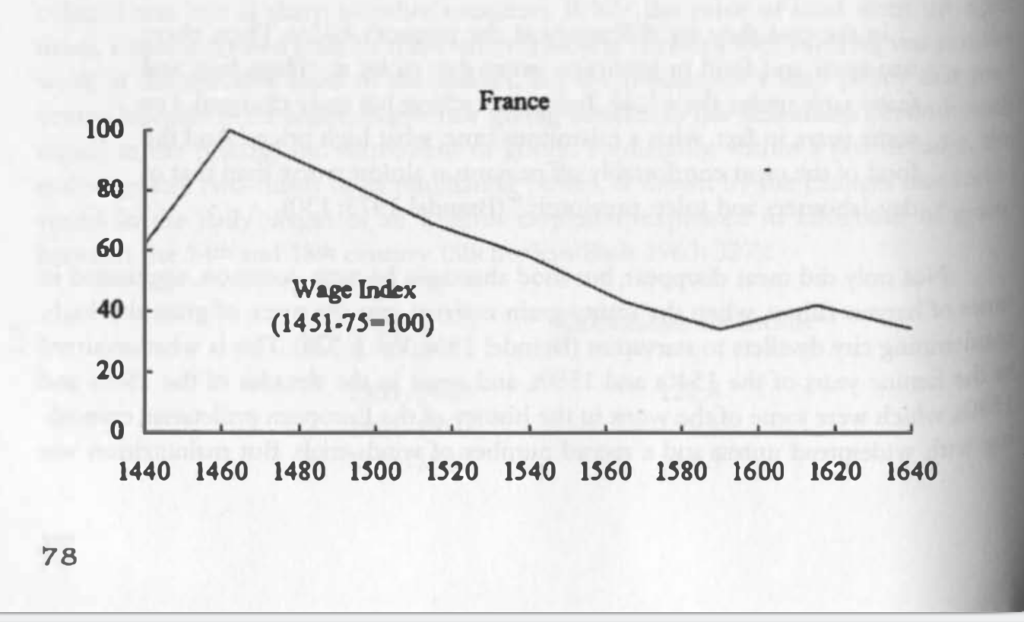
In this graph you can see the skyrocketing price of grain in England over two centuries.
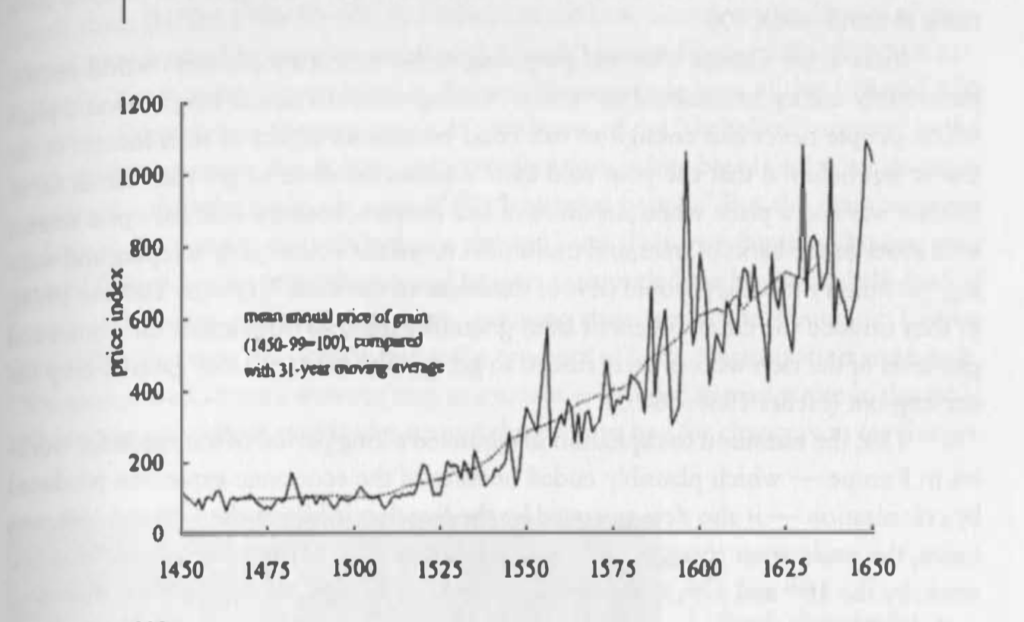
While capitalists would have you believe this is the rational invisible hand of the market, nothing could be further from the truth. Sister Federici says:
“This was not the work of the invisible hand of the market, but the product of a state policy that prevented laborers from organizing, while giving merchants the maximum freedom with regard to the pricing and movement of goods… What followed was the absolute impoverishment of the European working class, a phenomenon so widespread and general that, by 1550 and long after, workers in Europe were referred to as simply ‘the poor.’”
Page 76-77
The face of exploitation had now grown worse in this transition. The hatred and resentment among the workers against wage-labor kept growing, According to Sister Frederici,
“Such was the hatred that workers felt for waged labor that Gerrard Winstanley, the leader of the Diggers, declared that it did not make any difference whether one lived under the enemy or under one’s brother, if one worked for a wage. This explains the growth, in the wake of the enclosures, of the number of ‘vagabonds’ and ‘masterless’ men, who preferred to take to the road and to risk enslavement or death rather than to work for a wage.”
Page 72
This age of property and trade was also the age of beggars! It is true! The figures for the number of beggars in the sixteenth and seventeenth century are astounding! One-forth of the population of Paris in 1630 were beggars. In England, conditions were equally bad. Holland teemed with beggars, and in Switzerland, when there was no means of getting rid of beggars who besieged their housed or wondered in bands about the roads and forests, the wealthy even organized hunting parties against these wrenched homeless ones. What is the explanation of this widespread distress for the masses in a period of such great prosperity? Well, this prosperity was just for the few.
Migration, vagabondage, crimes against property, poaching, theft were all forms of resistance against wage-slavery. This graph shows the correlation between price increases and property crimes in Essex from 1566-1602.
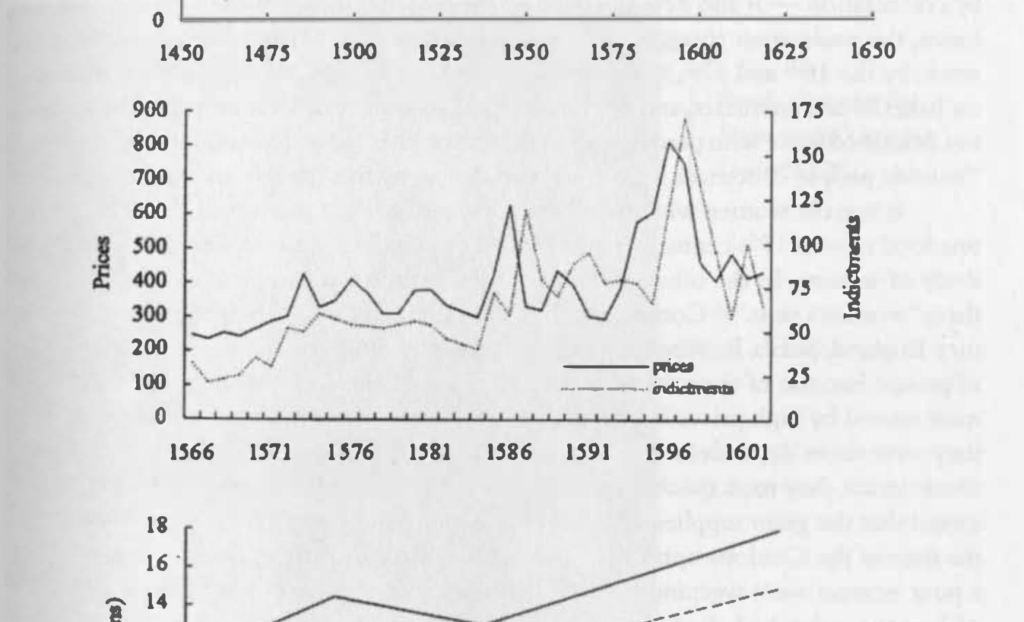
What a surprise. Sister Federici says:
“Pauperization, rebellion, and the escalation of ‘crime’ are structural elements of capitalist accumulation as capitalism must strip the work-force from its means of reproduction to impose its own rule.”
Page 82
Mercantilism demanded the lengthening of the working day to maximum hours and the reduction of wages to a minimum. Our Warlock friend Marx defined this as the exploitation to create an absolute surplus of wealth. The lengths mercantilism went to achieve absolute surplus of wealth makes thoughtless, liberal-minded capitalists from the first world blush, and has led to many capitalist theorists dismissing it as a crude & vulgar theory for understanding economics. Mercantilism was the teenage jock who never took no for an answer. Sister Federici says:
“The brutal means which the mercantilists applied in order to force people to work, in their hunger for labor have contributed to their disrepute, as most economists wish to maintain the illusion that capitalism fosters freedom rather than coercion. It was the mercantilist class that invented work-houses, hunted down vagabonds, ‘transported’ criminals to the American colonies, and invested in the slave trade, all the while asserting the ‘utility of poverty’ and declaring ‘idleness’ a social plague.” Mercantilism expresses primitive accumulation in its purest and most brutal forms. It was “the first capitalist policy explicitly addressing the problem of the reproduction of the work-force.”
Page 87
Fear not, dear viewer. My wand and I shall explain it all.
Mercantilism pictured human beings as mere raw materials, workers and breeders for the benefit & wealth of the state. So brutal were the tactics of the money-makers, the state had to criminalize vagabondage or any diminishment of the workforce. The state supported the creation of work-houses that ground the working man to his limits, and if that was unsuccessful, one could just as easily be labeled insane or a criminal for one’s irrational idleness and sent to a correctional-house for forced labor.
But, with every stick comes a carrot. By the mid 16th century, at least sixty European cities had public assistance programs. As meager and humiliating as the poor rates were, this no doubt helped prevent the flight of some labor from factories. However, many places required internments in the above mentioned work-houses to receive assistance.
Preventing the flight of people was essential for mercantilism. In the mid-16th century, the view that the number of citizens directly determines a nation’s wealth was considered self-evident. French political thinker and demonologist Jean Bodin said, “one should never be afraid of having too many subjects or too many citizens, for the strength of the commonwealth consists in men.” Italian economist Giovanni Botero declared the greatness of a city depended exclusively on the number of its residents.
Sister Federici says:
“the introduction of public assistance was a turning point in the state relation between workers & capital and the definition of the function of the state. It was the first recognition of the unsustainability of a capitalist system ruling exclusively by means of hunger and terror. It was also the first step in the reconstruction of the state as the gaurantor of the class relation and as the chief supervisor of the reproduction and disciplining of the work-force.”
Page 84
This is something the naive forget. In capitalism, there is no such thing as a state in opposition to the desires of capital. The state in a capitalist society is a capitalist state, whose goal is to uphold the capitalist system of political economy. Whether bailing out the banks in the 2nd millenia or the Elizabethan poor rates of the 16th century, a capitalist state’s duty is to prevent capitalism’s collapse from its own internal contradictions.
As Sister Federici wisely notes:
“It was with the introduction of public assistance that the state began to claim ‘ownership’ of the workforce, and a capitalist ‘division of labor’ was instituted within the ruling class, enabling employers to relinquish any responsibility for the reproduction of workers, in the certainty that the state would intervene.”
Page 84
We see the same today, where massive corporations rely on the state to give their impoverished workers state assistance to offset the poverty wages the workers receive. Meanwhile, profits are in the billions.
So much for the personal responsibility of the capitalist entrepreneur. (scoffs)
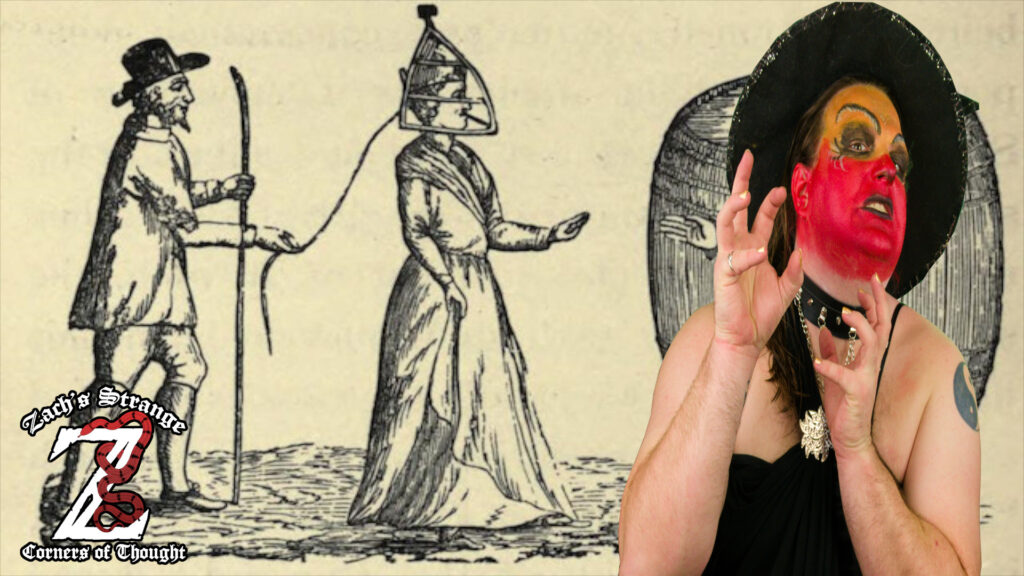
The Patriarchy of the Wage
During the transition, the most common riots were over food and women, like myself, were at the forefront across the continent. And, because of this, the government didn’t take much time discarding the earlier so-called status and privilege granted to women, and started their persecution. It was far more difficult for them to become meaningless beggars and vagabonds; all they did was to stand against the system. And they suffered the most for it.
The collapse of feudalism opened up markets and created a production-for-market economy. Wage-labor divided production from the reproduction of the species. Without a doubt, normalization of wage-labor was guided by the patriarchy; Sister Federici goes to great pains to write the history of the Patriarchy of wage-labor, a history which has long been forgotten or erased by even Warlocks like Marx.
Proletarian women found it increasingly difficult to get work; only the lowest forms of work were permitted women. Nearly a third of female workforce in Europe were domestic servants. Other vocations include: farm-hands, spinners, knitters, embroiderers, hawkers, wet nurses. In the law, in tax records, and in the hiring practices of the remaining guilds, women should not work outside the home. Their reproductive work wasn’t considered real work and was considered worthless in relation to the market. Even if women created clothes for the market, it was still considered domestic work. But, when men did the same jobs it was deemed productive. To the extent that women were allowed to work outside the home, it was either reproductive work for the benefit of the wealthy or productive work for the benefit of their husbands. In many places, from Austria to England, women working side-by-side with their husbands, creating the same products, received no wage. Their husbands were legally entitled to their wives wages. Sister Federici says:
“This policy, making it impossible for women to have money of their own, created the material conditions for their subjection to men and the appropriation of their labor by male workers. It is in this sense that I speak of the patriarchy of the wage. We must also rethink the concept of ‘wage slavery.’ If it is true that male workers became only formerly free under the new wage-labor regime, the group of workers who, in the transition to capitalism, most approached the condition of slaves was working-class women.”
Page 98
This devaluation created a more prominent sexual division of labor. It led to the creation by the 19th century of the full-time housewife and redefined women’s relationship to men. So, women went through double degradation in the transition to Capitalism compared to men.
“In this sense, the destiny of European women, in the period of primitive accumulation, was similar to that of female slaves in the American colonial plantation, who especially after the end of slave trade in 1807, were forced by their masters to become breeders of new workers.”
Page 75
So, this patriarchy of wage created a kind systematic exploitation in factories where two years old could apply! Women and children’s labor were bought cheap! The femininity of women started being redefined and the efforts were made to tame them, so that they could serve as better instruments in this reproduction of the labor force. Women lost their rights to represent themselves and to have any kind of political say because the devaluation of their labor meant the devaluation of their gender. It also reshaped the male and female relationship.
“The sexual division of labor that emerged … not only fixed women to reproductive work, but increased their dependence on men enabling the state and employers to use the male wage as a means to command women’s labor. In this way, the separation of commodity production from the reproduction of labor-power also made possible the development of a specifically capitalist use of the wage and of the markets as a means for accumulation of unpaid labor.”
Page 75
Federici’s contention contra Marx is that the alienation of the worker from their own productive labor and land grabs, while necessary, were not in themselves sufficient to guarantee capitalism’s ultimate victory. Only the enormous unpaid reproductive labor of women could have provided sufficient fuel for the capitalist fire of primitive accumulation.
Mercantilism didn’t just need absolute control of the exploitation of the work-force. No, it also needed complete control over the reproduction of the species. The best people for that is women, like myself (though #notallwomen and #transmenexist). Mercantilism was population obsessed, even fetishistic, if I dare say.
You see, the transition to capitalism caused a population decline hitherto unseen. Europeans exported death to the Americas.
The American Holocaust killed 95% of the population in South America in a mere century after the Spanish Conquista. The Mexican population went from 11 million in 1519 to 2.5 million in 1600. It was this Holocaust which necessitated the exportation of indentured servants to the Americas & Australia. And, when even that failed to meet production demands, the mid-Atlantic Slave Trade developed.
The population was also declining throughout Europe. While not as drastic as the Black Death a few centuries prior. So desperate for workers were the mercantilist class & state, that entire new fields of study around population developed creating a bio-power regime. This term bio-power comes from our dear Warlock friend Michel Foucault.
Sister Federici defines it in a note as:
“Bio-power expresses the growing concern, at the state level, for the sanitary, sexual, and penal control of individual bodies, as well as population growth and population movements and their insertion into the economic realm.”
Page 128 note 57
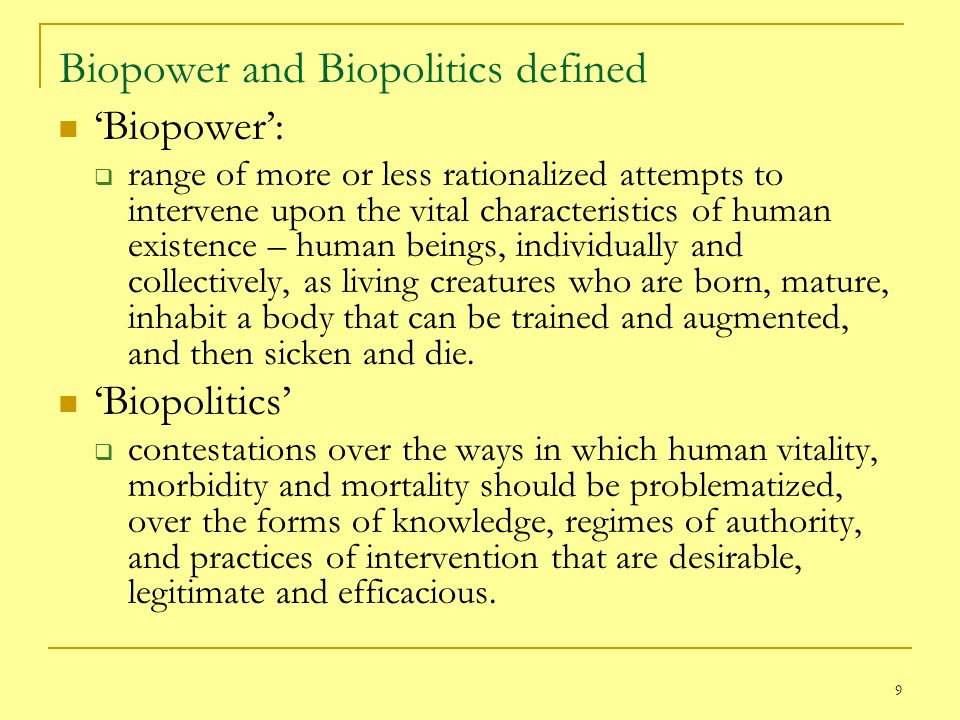
This may come off as surprising. Certainly, most civilizations have performed censuses. Which is true, but this was mainly done as a way to collect taxes. It was a negative power which took something from the population for the benefit of the state. Yet, the study of demographics which emerged in the transition was very different. It was positive. It wanted to know as much as it could about the population not only to control it, but to apply that knowledge to numerous fields of inquiry from medicine to industry in order to create more life and extend life longer. Knowledge is power, you have no doubt heard, and it is no different here either.
Theorists did not just sit in their ivory towers and castles fetishizing over demographic data; no! They put it too work. Women, like myself, excluded from the wage and increasingly enclosed in the home, had one duty: make babies. It is during this time that we see the criminalization of contraception, abortion, infanticide, and non-procreative sex (which is the best kind of sex in my opinion). No anal, no oral, no buggery, or harpsichord playing. What a dreary time to be alive.
But, that’s not all. In many places, women had to register their pregnancies with the local authorities. If an unregistered pregnancy ended in miscarriage, as is very common, the punishments against the woman was severe up-to-death even. Many midwives were banished from the birthing process, branded witches who used dark Satanic magic. This removed control over reproduction out of women’s hands; we lost control over our own reproductive functions. Men forced their way into the birthing chambers and prioritized the life of the unborn over the life of the woman. Women were enslaved to procreation; what had been previously a private affair became public, controlled by men & the state.
At the same time, in many places, rape was decriminalized. Often penniless lords raped working class women & girls leaving them little recourse to punish or prevent these violations.
“According to this new social-sexual contract, proletarian women became for male workers the substitute for the land lost to the enclosures, their most basic means of reproduction, and a communal anyone could appropriate and use at will … in the new organization of work every woman (other than those privatized by bourgeois men) became a communal good, for once women’s activities were defined as non-work, women’s labor began to appear as a natural resource, available to all, no less than the air we breathe or the water we drink.”
Page 97
This is significant. Under mercantilism, women were as much a resource to both capital & men as proletarian men were to capital. Though to be clear, our work is far more valuable than theirs.
Colonization, Globalization, Race and Women: the Invention of a Capitalist Epistemology
Just as essential to primitive accumulation was the colonization of the Americas and the Caribbean. Colonizers were able to use methods of discipline on enslaved people which even European workers did not experience. Sister Federici maintains that capitalism itself could not have taken off without the blood of the natives and imported slaves. It was not just the land stolen or the absolute labor expropriated that created the foundations of capitalism. But also the knowledge of the best methods to maximize profit.
“The plantation system was crucial for capitalist development not only because of the immense amount of surplus labor that was accumulated from it, but because it set a model of labor management, export-oriented production, economic integration and international division of labor that have since become paradigmatic for capitalist class relations.
“With its immense concentration of workers and its captive labor force uprooted from its homeland, unable to rely on local support, the plantation prefigured not only the factory but also the later use of immigration and globalization to cut the cost of labor. In particular, the plantation was a key step in the formation of an international division of labor that (through the production of ‘consumer goods’) integrated the work of slaves into the reproduction of the European work-force, while keeping enslaved and waged workers geographically and socially divided.”
Page 104
The knowledge and the power that came with it, of capitalism found its origin in the new world and it guaranteed capitalisms ultimate triumph by the 19th century.
Every method used to discipline the European proletariat was magnified one hundred fold in the Americas.
Whether natives, imported African slaves, or exported indentured servants, all resisted the brutalities of colonization. There was often solidarity amongst these three groups that threatened the colonial order at its core. We see in Shakespeare’s the Tempest one such plot against the colonizing order.
In The Tempest, a failed slave rebellion by Caliban is thwarted by Prospero showing the futility of rebelling against the masters.
This representation by our warlock friend no doubt portrays the very real anxieties and fears of colonizers on both sides of the Atlantic.
Colonizers had to do everything possible to divide & conquer. Indentured servitude eventually fell out of favor as it simply could not create the work-force needed to fill capitalism’s endless hunger. Slave labor was far more stable as you never had to free slaves, and enslaved people had less rights than indentured servants. The concept of whiteness began to form in order to separate the Europeans from the Africans & natives. The very concepts of racial differences (a distinction separate, though descended from ethnicity and nationality) is a purely capitalist invention that took centuries to develop. It started with Columbus getting lost and discovering a new world in 1492 and culminated in a complex, sophisticated study of alleged biological and cultural differences between races in the 19th century. Laws were made criminalizing any forms of fraternization between races, and whiteness became a psychological wage for whites. “Yes, your circumstances are abominable, but at least you’re free unlike those inferior black slaves over there.” Over the centuries, whiteness became synonymous with freedom, while blackness became synonymous with slavery.
Conclusion
This was a long one my dears, but it is the longest chapter in the book. In this video you learned everything you could ever want to know about the ins-and-outs of primitive accumulation, and not just the warlock, phallogocentric history normally taught. We looked at the economic precursor to capitalism, mercantilism, and the greatest land grab in history, and the domestication of the work-force, the loss of the commons and the solidarity and autonomy that came with them, the patriarchy of wage-labor and the disciplining of women towards permanent housewives, i.e., permanent unpaid reproductive labor. And the centrality of colonization and slavery to the development of capitalism.
In the next chapter, The Great Caliban: The Struggle Against the Rebel Body, we will focus on the philosophical theories inherent to capitalism’s discipline of the body.
